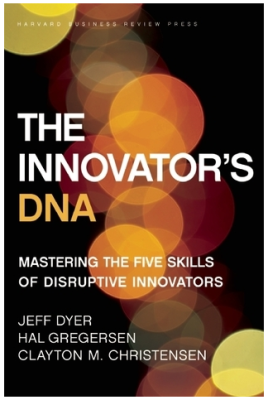The Innovator’s DNA: Mastering the Five Skills of Disruptive Innovators
 (May 2, 2014) A collaborative effort by Jeffrey Dyer, Hal B. Gregersen and Clayton M. Christensen. The book is really good and I loved the concepts and the examples they use. I felt it was longer than it needed to be.
(May 2, 2014) A collaborative effort by Jeffrey Dyer, Hal B. Gregersen and Clayton M. Christensen. The book is really good and I loved the concepts and the examples they use. I felt it was longer than it needed to be.
The basic concept of “the innovator’s DNA” is that people engage in certain types of specific behaviors that impact how well they are able to innovate. Those behaviors are Associating, Questioning, Observing, Networking and Experimenting. In using Associational Thinking (Associating), the authors posit that innovation breakthroughs happen at the intersection of diverse disciplines and fields. It’s also called the Medici Effect. I have experienced that firsthand and know the value of having diverse interests, friends and talking with everyone no matter what it is they do.
In creating innovative ideas, it’s necessary to put things together in new and novel combinations. There are many great “real world” examples of this in the book that any reader would recognize. For instance: wireless + computers = Blackberry. There is also an acronym for remembering the actions we must take in the process of innovating: SCAMPER
S: Substitute
C: Combine
A: Adapt
M: Magnify, Maximize, Modify
P: Put to other uses
E: Eliminate
R: Reverse, Rearrange
They also cover the “Five Why’s Process” in which we “don’t invent the answers, you reveal the answers by asking the right questions.” The authors emphasize that understanding the functional, social and emotional dimensions of a job to be done can be complex. They give examples of how companies like Proctor & Gamble create technical briefs describing specific problems and put it out for contractors to offer a solution. They have developed many well known products using this method.
At the end of the book, they suggest looking at how we spend our time and whether we are engaging in the behaviors and activities that feed innovation. That suggestion includes keeping track of how we spend our days and what percentage of our time is spent on discovery, development and delivery of new ideas, products and services. There is very practical advice in this book and it’s a very worthwhile read. Quite often these days I find myself wishing the authors of business books would dramatically reduce the number of examples, thereby shortening the length of the book. This would have benefitted from a trimming of the fat around the edges.